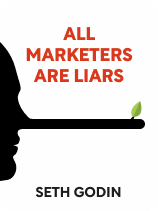

This article is an excerpt from the Shortform book guide to "All Marketers are Liars" by Seth Godin. Shortform has the world's best summaries and analyses of books you should be reading.
Like this article? Sign up for a free trial here .
Do you understand your customers’ perspective? Do you know how to appeal to that worldview?
Seth Godin argues that it’s vital to understand your customers’ perspective—their worldview. He discusses what a worldview is, why it’s important, and how to appeal to a perspective using frames, euphemisms, and oxymorons.
Read more to learn about the customers’ perspective.
Your Customers’ Perspective
The key to good marketing is a good story. To tell a better story, it’s best to appeal to a worldview, the way someone sees the world. Godin’s first principle of modern marketing is that a good story starts with a specific worldview. When you can tell a story about your idea or product that aligns with a customer’s perspective or worldview, you’ll not only satisfy their wants and needs but validate their beliefs.
What Is a Worldview?
Godin defines a worldview as the set of beliefs, values, and biases that determines how a customer sees and interacts with the world. While everyone has the same basic wants and needs (food, shelter, to be happy, healthy, and so on), Godin explains that their worldview determines how they fulfill them.
For example, what’s the difference between someone on a Keto diet (which emphasizes consuming a high percentage of fat) and someone on a plant-based diet? Both people probably feel that they have found a dietary lifestyle that balances health and nutrition. They have found two different solutions to one common goal, meaning they have two different perspectives or worldviews.
Often, people with similar worldviews group into small niches or micro-communities. Godin says a marketer’s success lies in finding the right group of people with a shared worldview and telling them a compelling story that aligns with that perspective.
| Understanding and Changing Worldviews Stephen Covey’s 7 Habits of Highly Effective People suggests another way to define worldviews, which he calls paradigms. He defines paradigms as the lenses through which you see the world and that shape how you interpret your situations and surroundings. These interpretations dictate your behavior, much like Godin’s idea of worldviews influencing you to buy a product. Our sense of self is often tied to our worldview. We usually have an automatic, defensive response to information that threatens our worldview, and therefore, our sense of self. We also tend to dismiss facts that don’t conform to our worldview (also known as confirmation bias). This can be tricky to navigate as a marketer. So how do you do it? Covey offers an answer for how to change a perspective. He proposes becoming aware of your biases, identifying the worldviews you want to adopt, and shifting your perspective. While his writing is geared toward individuals wanting to adjust their worldviews, advertisers can tailor his ideas to their marketing story to thoughtfully address a worldview. Ask yourself: What bias are you addressing? How does your product answer that worldview? Does it offer a better solution or new reality? |
How Do Worldviews Affect What People Buy?
Now that we know what a worldview is, let’s discuss how a worldview or perspective influences your customer’s shopping habits. Godin claims worldviews can affect three customer attributes: their attention, their biases, and the language they expect.
Attention
Your customer’s perspective is one factor that determines whether she’ll notice your product. For example, someone who’s vegan probably won’t notice your new steakhouse. Attention is hard to get, so it’s best to get the attention of people who want to give it—that is, those whose worldview aligns with your product.
| Permission and Viral Marketing Godin pioneered the concept of permission marketing in his book of the same name, where the marketer gets permission from the customer to send her product information. The idea is to get the attention of people who want to give it or who are already paying attention. It contrasts with interruption marketing, which was the old advertising method of fighting for consumers’ attention through active promotion. There are a few key elements to permission marketing: It’s anticipated: Consumers expect to receive information from the marketer. It’s personal: The information relates to the individual consumer. It’s relevant: Consumers are interested in the information. Permission marketing is often associated with email marketing, where consumers opt in to getting information from marketers. This is a more cost-efficient tactic because marketers rely on low-cost methods (like email or social media) to target interested consumers. This leads to a higher conversion rate of leads to sales, and it builds consumer trust. |
Biases
Although Godin isn’t clear about how worldviews and biases interact, we can infer that our worldview makes us prone to certain assumptions. Take the previous example of the vegan and your new steakhouse. Because of their worldview, someone following a vegan diet will probably have a knee-jerk reaction or bias against your steakhouse. People carry biases that affect their initial impressions of products, people, and ideas. They like having their worldviews and underlying biases confirmed, not challenged.
| Biases in Marketing Godin uses “biases” to define “worldview,” but then he goes on to say that our worldview affects our biases, which is a bit confusing. Regardless, the key point is that it’s important to understand the various forms of biases and how marketers can overcome them. A bias is an inclination in favor of or against an idea, person, thing, belief or group. Biases can be learned or innate, and we’re often unaware of them. There are also several different kinds of biases, as Richard H. Thaler and Cass R. Sunstein explain in Nudge: anchoring, availability, representativeness, status quo, and loss aversion. We’ll talk about the status quo bias, because that’s the one marketers have to overcome most often. The status quo bias is our tendency to stick with our current option or situation—usually for no good reason. Status quo bias frequently affects our decision-making. For marketers, this means that consumers are prone to keep buying the same products they always have. How often do you change the type of toothpaste you buy? You probably have a chosen brand and flavor. That’s status quo bias at play. As a marketer, how can you encourage consumers to break out of their status quo bias and try your product? First, consider spending more time listening to consumer needs and feedback. Read reviews, and look for gaps in the market. Then, tell the consumer how the current status quo is a losing proposition and what they have to gain from your product. |
Language
Customers expect to hear certain messages in certain ways. Think about perfume commercials—they follow a distinct format and theme.
Godin explains that language isn’t limited to specific words used. It can come in the structure of the message, the colors used, or the overall mood of your ad. Make sure the way you tell your story aligns with your customers’ perspective and the story you’re trying to tell. How you tell your story includes all of the text, images, design, and employees that go into selling your idea.
| Words Can Hurt Your Marketing The way you tell your story is just as important as the story itself. A change in one word could make all the difference in your marketing campaign. One company found that changing their checkout button from “+Cart” to “Add to Cart” increased clicks by 49%. So how do you choose your words carefully? Consider connotations. What’s the difference between “Sign Up Now” and “Are You Ready to Get Started?” One is overused and forgettable, while the other creates a sense of excitement. Simplify your message. In Positioning, the authors note that simple messages can be more effective, because they’re better able to cut through the noise. Our brains can only juggle a few ideas at once, so it’s best not to overload customers with too much complex information. Perfect the word choice in your call to action. Your goal as a marketer is to get consumers to act. This usually means buying your product, but it could also look like signing up for emails. So focus on getting your call to act right. |
How to Appeal to a Worldview
Now that you know what a worldview is and how it affects customers, how can you use that to tell a better story? How do you tell a story that doesn’t conflict with your customers’ perspective? And how do you control the story around something that could be viewed as a negative? Godin says using frames, euphemisms, and oxymorons can help you align your story with a worldview.
Frames
According to Godin, framing is a way to spin your story to encompass or resonate with a customer’s worldview. Framing your story can also give you some control over the customer’s initial impression of your product. (Godin later expands on how important the first impression is, as we’ll discuss in Principle 3).
Take this example: A university notices that its freshman enrollment rate has been declining. They decide to frame a new story to welcome nontraditional students. Rather than presenting themselves as a school with the typical college experience (Greek life, clubs, and so on), the university decides to appeal to people who don’t fit the usual 18-year-old college freshman mold. By framing their story to appeal to nontraditional students, they may expand their prospect pool and reverse their declining enrollment.
| Framing in Politics As linguist George Lakoff writes in Don’t Think of an Elephant, politicians and political correspondents frequently use framing to speak to certain biases and thereby gain support. He describes political frames as “mental structures that shape the way we see the world,” which echoes Godin’s idea of worldviews. Godin also recognizes the role of worldviews and framing in politics—for instance, in the way George W. Bush and John Kerry campaigned in the 2004 presidential election. He says they both flip-flopped on issues, but Bush told the story about Kerry being a flip-flopper first. Kerry tried to counter it (saying Bush flip-flopped too), but by then, Bush’s story had stuck. Godin says the best tactic is to tell the story first. Lakoff also stresses the importance of not using your opponent’s language, because it strengthens the association with their argument. So every time Kerry tried to tell the public a story about Bush being a flip-flopper, it made people think of Bush’s earlier claim that Kerry was a flip-flopper. Creating a frame (or worldview) takes time. Lakoff uses the example of the conservatives’ “tax relief” bill. They had spent years framing taxes as a burden, making it part of their political platform and ethos. When George W. Bush proposed tax cuts, conservatives won support by calling it “tax relief,” which played off the idea that taxes are bad. “Tax relief” was framed as something that would relieve a burden on people. |
Euphemisms
Euphemisms are different names for the same idea. They are used to steer away from negative connotations or biases someone may have about an idea and help you frame it more favorably.
An example is substituting “athleisure” for “workout gear.” Athleisure (the euphemism) appeals to someone who values looking stylish, even while sweating through their workout. On the other hand, “workout gear” may still be fine for someone who just wants to go to the gym to sweat. Your language depends on which type of customer you want to appeal to. (Shortform note: To use euphemisms effectively in marketing, avoid these pitfalls: Don’t exaggerate the value of the product, don’t mislead, don’t minimize an important issue, and don’t be so obscure that people don’t know what you’re talking about. Instead, try to be creative, positive, inspirational, and mysterious,)
| Marketing Is Like a Camera Throughout the book, Godin describes worldviews as a lens. What does he mean? Let’s compare it to taking a picture: a still life of a fruit basket. The photographer is the consumer. The fruit basket is the product you’re marketing. The camera they’re looking through is their worldview, and the type of camera, whether an iPhone or DSLR, affects how the fruit basket looks when they view it. Framing is how you, the marketer, set up the display: Is a certain fruit positioned toward the front? Is the background black to draw the customer’s eye to the fruit and create a moody atmosphere? Or is it yellow to evoke a sense of happiness and fun? What’s the lighting like? As you can see, many different frames could be applied to alter how the fruit looks to the photographer/customer. Notice how we said “still life of a fruit basket” and not “pile of fruit”? There’s the euphemism. |
Oxymorons
Like a euphemism, an oxymoron is a way to frame an idea, but by combining contradictory words in a phrase. With oxymorons, you can use new words or phrases for an old concept in order to avoid negative connotations or to catch the consumer’s attention. You can target people who have two worldviews that seem like they’re at odds with each other.
For example, “non-alcoholic beer” is an oxymoron because beer is, by definition, alcoholic. This phrasing appeals to someone who likes beer but doesn’t want the inebriating effects that come with drinking alcohol.
| Godin’s Oxymorons Godin uses the word oxymoron a lot, particularly on his blog. While oxymorons tend to be words or phrases, Godin also refers to ideas that confound expectations by surprising the reader with a contrast as oxymorons. His usage is similar to a juxtaposition, where two ideas are placed next to each other for a contrasting effect. For example, in a blog post, “What will be on your tombstone,” Godin points out that articles about Google often mention that the company serves employees lunch prepared by the former chef for the band the Grateful Dead. He calls this memorable factoid an oxymoron, although it isn’t an oxymoron in the traditional definition. In terms of what that means for your marketing, Godin seems to recommend that you throw the audience an interesting curveball—something they weren’t expecting to hear. |

———End of Preview———
Like what you just read? Read the rest of the world's best book summary and analysis of Seth Godin's "All Marketers are Liars" at Shortform .
Here's what you'll find in our full All Marketers are Liars summary :
- The difference between lying and telling a great story
- How to better understand your customer
- How to overcome common obstacles you’ll encounter in marketing






